A Healthy Post Hysterectomy Diet Plan – The Ultimate Guide
Welcome to your guide on maintaining a healthy post-hysterectomy diet plan. Taking care of your body after surgery is essential for a smooth recovery. Following an appropriate diet can optimize healing and avoid common bowel problems. This guide will provide essential nutritional advice to promote a healthy recovery.
This blog is reader-supported. When you buy through a link on our site, we earn a commission at no extra cost to you. Read more
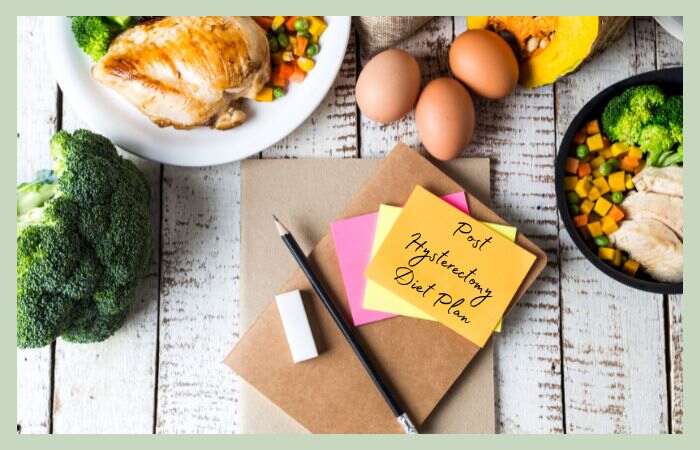
The Importance of a Hysterectomy Recovery Diet
After undergoing a hysterectomy, following a proper recovery diet is essential for promoting healing and managing postoperative bowel problems. Your body requires adequate nutrition to support tissue repair and optimal health.
By providing the necessary nutrients, a hysterectomy recovery diet can optimize your healing process and help you return to your normal activities sooner.
It is essential to understand that every individual’s dietary needs may vary. Using the services of a doctor or dietitian can help you develop a diet plan that works for you. They can examine your overall health, pre-existing conditions, and dietary restrictions.
Consider incorporating foods that promote tissue healing and bowel health when planning your hysterectomy recovery diet.
Remember, a hysterectomy recovery diet is just one aspect of your overall recovery plan. Making other lifestyle changes, such as engaging in low-impact exercises, prioritizing sleep, and reducing stress, is essential. With a holistic approach to recovery, you can optimize your healing process and promote a smooth transition back to a healthy, active life.
“Following a proper hysterectomy recovery diet can support tissue healing and help manage postoperative bowel problems, essential for smooth recovery.”
Best Foods to Promote Tissue Healing
During recovery from a hysterectomy, you need to prioritize your diet.
The consumption of protein-rich foods can significantly aid in the recovery process.
Protein is crucial for forming new tissues and helps speed up wound healing.
You can repair damaged tissues by including various lean protein sources in your diet.
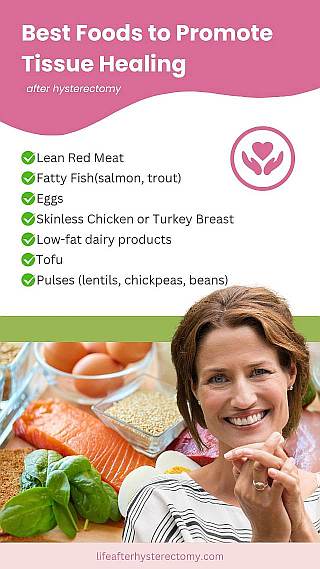
Protein Sources for Healing After Hysterectomy
Incorporating these protein-rich foods into your post-hysterectomy diet can support tissue healing and optimize recovery.
| Protein Source | Protein Content (per 3-ounce serving) |
|---|---|
| Lean Red Meat (beef or lamb) | 22-25 grams |
| Fatty Fish (salmon or trout) | 20-25 grams |
| Skinless Chicken or Turkey Breast | 24-26 grams |
| Eggs | 6-8 grams |
| Pulses (lentils, chickpeas, black beans) | 7-9 grams |
| Tofu | 8-10 grams |
| Low-fat dairy products (Greek yogurt, cottage cheese) | 15-20 grams |
Aiming for 2.5-3 daily servings of protein is recommended to ensure an adequate intake for tissue healing after a hysterectomy. Additionally, incorporating other nutrient-rich foods, including vegetables, fruits, whole grains, and healthy fats, benefits health and wellness by providing essential vitamins, minerals, and antioxidants.
Restoring the Gut Microbiome after Hysterectomy
The use of antibiotics and the surgery itself can disrupt the gut microbiome after a hysterectomy.
This disruption can lead to bowel problems and digestive discomfort. However, there are steps you can take to restore and maintain healthy gut bacteria, which is crucial to a healthy gut and general health.
One effective way to restore the gut microbiome after hysterectomy is by including prebiotic foods in your diet.
Prebiotics are a type of fiber that provides fuel to our gut bacteria. They help these bacteria thrive and multiply, promoting a diverse and balanced gut microbiome.
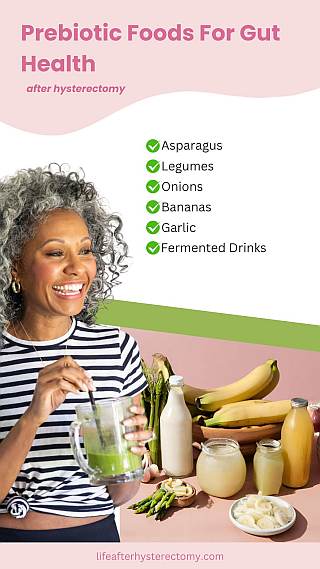
Prebiotic Foods for Gut Health after Hysterectomy
Asparagus -Rich in prebiotic fiber, asparagus boosts the health of your gut microbiome.
Bananas contain resistant starch, a prebiotic fiber supporting gut bacteria growth.
Legumes – Legumes like chickpeas and lentils are high in fiber and nourish the gut microbiome.
Onions – Onions are rich in prebiotic compounds called fructooligosaccharides, which are also great for gut health.
Garlic – Garlic contains prebiotic compounds that help promote the growth of beneficial bacteria in the gut.
Fermented Drinks – Drinks like kefir and kombucha contain live microorganisms that can help restore the gut microbiome.
Following a hysterectomy, you can strengthen your gut microbiome by including these prebiotic foods.
Managing Hysterectomy Constipation Through Diet
Constipation is a common problem after hysterectomy, but there are dietary measures you can take to help prevent and alleviate it. Including high-fiber foods in your diet can promote regular bowel movements and soften stool, making passing easier.
Consume 25-30 grams of fiber each day. This will help to keep your digestive system functioning smoothly
Foods high in fiber to help manage constipation after hysterectomy:
- Fruits: Apples, berries, oranges, and pears
- Vegetables: Broccoli, spinach, kale, and carrots
- Legumes: Lentils, chickpeas, and black beans
- Whole grains: Brown rice, quinoa, and whole wheat bread
- Seeds: Chia seeds, flaxseeds, and pumpkin seeds
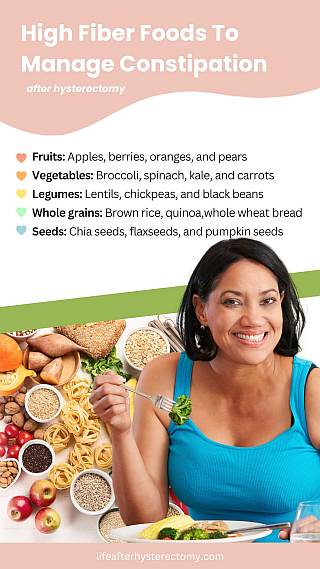
It’s also important to stay hydrated to maintain regular bowel movements. Keep hydrated throughout the day. Don’t drink caffeinated drinks or alcohol, as they dehydrate you.
“A fiber-rich diet and staying hydrated are key to managing constipation after hysterectomy. See your doctor if you have any issues and for personalized advice.”
Tips to Soften Stool after Hysterectomy:
1. Include fiber-rich foods like fruits, vegetables, legumes, whole grains, and seeds.
2. Drink plenty of water and limit your intake of caffeinated beverages and alcohol.
3. Avoid foods that can firm the stool, such as processed foods, dairy products, and foods high in saturated fat.
4. Do regular exercise to promote healthy bowel function.
Fiber-Rich Foods
| Fiber-Rich Foods | Serving Size | Fiber Content (grams) |
|---|---|---|
| Apples | 1 Medium | 4 |
| Broccoli | 1 cup, chopped | 5 |
| Black beans | 1/2 cup, cooked | 7 |
| Quinoa | 1 cup, cooked | 5 |
| Chia seeds | 2 Tablespoons | 10 |
What to eat to reduce gas and bloating
It’s common to experience gas pain and bloating after a hysterectomy. Specific dietary changes can ease these discomforts. Avoiding certain foods and adding others can reduce gas and bloating, promoting a more comfortable recovery.
Foods to Avoid for Gas and Bloating After Hysterectomy
| Foods to Avoid | Alternative Options |
|---|---|
| Brassica family vegetables (broccoli, cauliflower, cabbage) | Leafy greens (spinach, kale, Swiss chard) |
| Peas and beans | Quinoa, lentils |
| Onions | Herbs and spices for flavoring |
| Pears | Berries, apples |
| Dried fruits | Fresh fruits |
| Bran | Whole grains (oats, brown rice) |
| Artificial sweeteners | Natural sweeteners (honey, maple syrup) |
| Caffeine | Herbal teas |
| Carbonated drinks | Water, infused water, herbal teas |
In addition to avoiding gas-producing foods, try eating smaller, more frequent meals. This helps prevent overeating, which can contribute to increased gas and bloating. Taking time to eat and chew helps minimize the air swallowed, reducing gas buildup.
Remember to listen to your body. Try to identify which foods may trigger gas and bloating. Each individual is unique, and certain foods may affect people differently. It’s handy to keep a food diary so you can identify potential culprits in your diet and eliminate them.
By making simple diet adjustments and paying attention to what you eat, you can effectively reduce gas and bloating after a hysterectomy, making your recovery easier.
Recommended Foods for The Post-Hysterectomy Diet
After undergoing a hysterectomy, it is important to focus on consuming nutritious foods to promote a speedy recovery. Your diet heavily influences this. You need to provide your body with the essential nutrients necessary for healing and supporting overall health.
Besides fiber-rich foods and lean protein sources mentioned before, here are some recommended foods to include in your post-hysterectomy recovery diet:
✔ Calcium-Rich Foods:
Calcium is vital for maintaining bone health and preventing osteoporosis after hysterectomy. Use dairy products like low-fat milk, yogurt, and cheese, or choose non-dairy sources like almonds, kale, and fortified plant-based milk.
✔ Phytonutrient-Rich Fruits and Vegetables:
Phytonutrients help reduce inflammation and support the immune system. Ensure you incorporate colorful fruits and vegetables like berries, citrus fruits, tomatoes, spinach, and bell peppers into your meals.
✔ Phytoestrogen-Rich Foods:
Phytoestrogens can help manage hormonal changes after a hysterectomy. To obtain these beneficial plant compounds, add soybeans, flaxseeds, chickpeas, and lentils to your post-hysterectomy diet.
Remember to stay well hydrated throughout your recovery period. Water is the best beverage. But stay away from sugary drinks and caffeine. They can hinder the healing process.
Foods To Avoid After Hysterectomy
After undergoing a hysterectomy, it is important to be mindful of certain foods that may hinder healing and increase the risk of complications.
Promote a smoother recovery and optimize your overall well-being by staying clear of these items.
Here are some key foods to avoid after hysterectomy:
Avoid Sweets and Processed Foods
Highly processed foods and sweets should be limited or avoided altogether. They often contain high levels of refined sugars, unhealthy fats, and artificial additives, which compromise the immune system and delay healing.
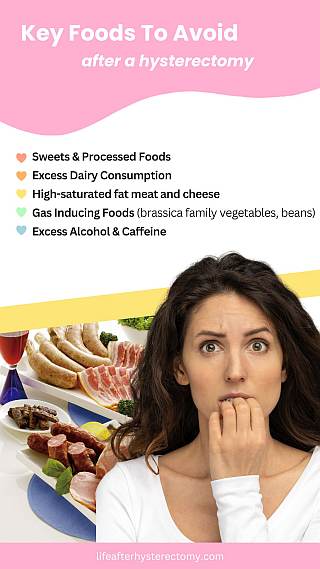
Instead, focus on whole, unprocessed foods that provide essential nutrients and support your body’s natural healing mechanisms.
Limit Excess Dairy Consumption
Even though dairy products are a great source of calcium and protein, consuming excessive amounts after a hysterectomy may contribute to inflammation and digestive discomfort. If you have difficulty tolerating dairy, opt for low-fat or non-dairy alternatives, and be mindful of your overall intake to support optimal healing.
Reduce Intake of High-Saturated Fat Meat and Cheese
The consumption of saturated fats, such as fatty meat cuts and full-fat cheese, can increase inflammation and slow healing. Instead, choose leaner protein sources like poultry, fish, and legumes, which provide essential nutrients without the adverse effects of excessive saturated fat.
Avoid Gas-Inducing Foods
After a hysterectomy, foods that can cause gas and bloating are best avoided, as they can contribute to discomfort and digestive issues. Some common culprits include brassica family vegetables (like broccoli and cabbage), beans, peas, onions, pears, dried fruits, bran, artificial sweeteners, caffeine, and carbonated drinks. Opt for low-gas alternatives and focus on foods that are easier to digest to promote a more comfortable recovery.
Avoiding these foods and making mindful choices can support your body’s healing after a hysterectomy.
| Foods not to eat after hysterectomy | Alternatives |
| Sweets and processed foods | Whole, unprocessed foods |
| Excess dairy consumption | Low-fat or non-dairy alternatives |
| High-saturated fat meat and cheese | Legumes, poultry, and fish are all good sources of lean protein |
| Gas-inducing foods (brassica family vegetables, beans, peas, onions, pears, dried fruits, bran, artificial sweeteners, caffeine, carbonated drinks) | Low-gas alternatives and easily digestible foods |
Importance of Hydration in Hysterectomy Recovery

Staying hydrated is essential for your recovery after a hysterectomy. Proper hydration helps flush toxins, regulate bowel movements, and promote overall healing. Drinking plenty of water and other fluids is recommended to support your body’s needs during this time.
Fluids to drink after hysterectomy include:
✔ Water: Drink at least eight to ten glasses of water each day. Carry a water bottle to ensure you stay hydrated throughout the day.
✔ Herbal Teas: Chamomile, peppermint, and ginger herbal teas can soothe the digestive system and provide additional hydration.
✔ Fresh Fruit Juices: Juices made from fresh fruits like oranges, grapefruits, and berries can provide hydration, essential vitamins, and antioxidants.
Remember to listen to your body’s thirst cues and drink fluids regularly. Be cautious with caffeinated and sugary beverages, which can dehydrate the body. Water is your best bet for staying hydrated.
Related post: Transformative Weight Loss Workouts For Women Over 50 – Try This 7-Day Plan
What are some recommended meal ideas for the post-hysterectomy diet?
Here are some meal ideas for your post-hysterectomy diet plan:
Soups – Broth-based soups like chicken noodles or vegetable soup are easy to digest. Avoid creamy soups. You can try, for instance, this Comforting Easy Homemade Vegetable Soup.
Lean proteins: Good options include fish, chicken, eggs, beans, and lentils. Choose baked, grilled, or poached preparations rather than fried.
Whole grains – Brown rice, quinoa, whole wheat pasta, oatmeal. These provide fiber, which aids digestion.
Steamed vegetables – Choose tender veggies like carrots, zucchini, green beans, and spinach. Avoid raw veggies at first.
Fruit – Fresh or canned fruit like bananas and applesauce are gentle on the gut.
Yogurt – Greek yogurt provides protein and probiotics for gut healing.
Smoothies – Blend yogurt, milk, and fruit for an easy-to-digest meal. Here is a recipe for a mixed Berry Smoothie with yogurt and banana.
Eggs – Scrambled eggs and omelets are light yet filling choices.
Sandwiches – Try lean turkey or tuna on whole-grain bread with light toppings.
Baked potato – Top a baked potato with broth, beans, or a small amount of cheese.
Pasta salad – Whole wheat pasta with diced veggies and olive oil-based dressing. Check out this delicious Light and Easy Pasta Salad recipe.
The key is choosing mild, non-spicy, gentle foods for the digestive system while it heals post-surgery. Focus on protein, fiber-rich whole grains, and plenty of fluids.
the immediate recovery period
Dietary options for early postoperative hysterectomy recovery should ideally include foods your body can tolerate.
You will likely feel more sensitive during the early stage of hysterectomy recovery. Foods that cause constipation, diarrhea, gas, or bloating can also cause abdominal discomfort, particularly if you already suffer from bowel issues.
Early in their recovery, some women prefer eating bland foods containing easily digestible high-protein sources. Observe how your body responds to your food and adjust your diet based on your physical symptoms and overall well-being.
Conclusion
In conclusion, a post-hysterectomy diet plan is essential for optimal recovery and overall health. Following the recommended dietary guidelines can promote healing, manage common bowel problems, and minimize potential complications.
Key takeaways from a healthy hysterectomy recovery diet include:
- Prioritizing protein intake for tissue healing.
- Restoring the gut microbiome through prebiotic foods.
- Managing constipation with high-fiber foods.
- Reducing gas and bloating by avoiding certain gas-producing foods.
Additionally, it is essential to stay hydrated, incorporate lifestyle changes such as low-impact exercises and adequate sleep, and prioritize self-care after a hysterectomy.
Read also: The Secret To Hysterectomy Weight Loss And How To Do It Right.

